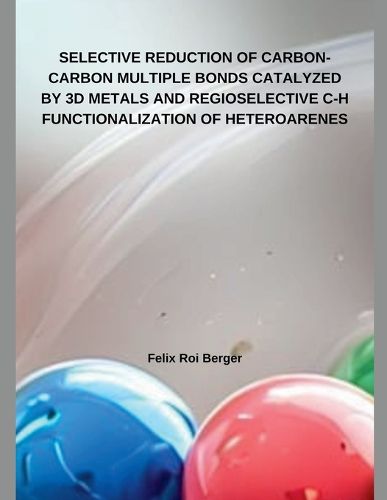Readings Newsletter
Become a Readings Member to make your shopping experience even easier.
Sign in or sign up for free!
You’re not far away from qualifying for FREE standard shipping within Australia
You’ve qualified for FREE standard shipping within Australia
The cart is loading…






Hydrogenation is a cornerstone of synthetic chemistry that offers a powerful means to selectively modify functional groups within complex molecular structures. Since the early 20th century, catalytic hydrogenative processes have grown and advanced significantly with the help of many transition metal catalysts. For example, well-known hydrogenation catalysis such as Pd or Pt on carbon in the presence of H2 are employed for the catalytic hydrogenation of multiple bonds. However, the lack of selectivity in such a heterogeneous hydrogenation process resulted in multiple product formation. Hence researchers moved toward homogeneous hydrogenation processes that are much milder and more product-selective.1 Over the time, ruthenium, rhodium, palladium, and iridium, the 4d and 5d transition metals have played a significant role in the homogeneous hydrogenation process with molecular hydrogen. While homogeneous hydrogenation reactions resulted in improved product selectivity and were achieved under milder conditions, the heavy 4d/5d transition metals were expensive, naturally less abundant, and toxic.2-4 As a result, more affordable, naturally abundant and relatively non-hazardous 3d transition metals were employed instead for these changes.5 In recent years, the pursuit of chemoselective hydrogenation methods has gained significant attention. Chemoselective hydrogenation refers to the chemoselective hydrogenation of one unsaturated moiety in the presence of others within a molecule. Driven by the imperative to streamline synthetic routes while minimizing waste and maximizing atom economy, 3d-metal catalysis emerges as a promising frontier, offering unparalleled precision and efficiency in the selective reduction of multiple functional groups. Traditional hydrogenation processes often suffer from a lack of selectivity, necessitating laborious protection and deprotection steps or leading to undesired side reactions.6-8 The advent of 3d-metal catalysts has revolutionized this landscape, enabling direct and chemoselective hydrogenation of specific functional groups within complex organic frameworks. By harnessing the unique coordination environments and electronic properties of 3d-metal complexes, various research groups have unlocked a new realm of catalytic selective hydrogenation, paving the way for more sustainable and efficient synthetic pathways.
$9.00 standard shipping within Australia
FREE standard shipping within Australia for orders over $100.00
Express & International shipping calculated at checkout
Hydrogenation is a cornerstone of synthetic chemistry that offers a powerful means to selectively modify functional groups within complex molecular structures. Since the early 20th century, catalytic hydrogenative processes have grown and advanced significantly with the help of many transition metal catalysts. For example, well-known hydrogenation catalysis such as Pd or Pt on carbon in the presence of H2 are employed for the catalytic hydrogenation of multiple bonds. However, the lack of selectivity in such a heterogeneous hydrogenation process resulted in multiple product formation. Hence researchers moved toward homogeneous hydrogenation processes that are much milder and more product-selective.1 Over the time, ruthenium, rhodium, palladium, and iridium, the 4d and 5d transition metals have played a significant role in the homogeneous hydrogenation process with molecular hydrogen. While homogeneous hydrogenation reactions resulted in improved product selectivity and were achieved under milder conditions, the heavy 4d/5d transition metals were expensive, naturally less abundant, and toxic.2-4 As a result, more affordable, naturally abundant and relatively non-hazardous 3d transition metals were employed instead for these changes.5 In recent years, the pursuit of chemoselective hydrogenation methods has gained significant attention. Chemoselective hydrogenation refers to the chemoselective hydrogenation of one unsaturated moiety in the presence of others within a molecule. Driven by the imperative to streamline synthetic routes while minimizing waste and maximizing atom economy, 3d-metal catalysis emerges as a promising frontier, offering unparalleled precision and efficiency in the selective reduction of multiple functional groups. Traditional hydrogenation processes often suffer from a lack of selectivity, necessitating laborious protection and deprotection steps or leading to undesired side reactions.6-8 The advent of 3d-metal catalysts has revolutionized this landscape, enabling direct and chemoselective hydrogenation of specific functional groups within complex organic frameworks. By harnessing the unique coordination environments and electronic properties of 3d-metal complexes, various research groups have unlocked a new realm of catalytic selective hydrogenation, paving the way for more sustainable and efficient synthetic pathways.